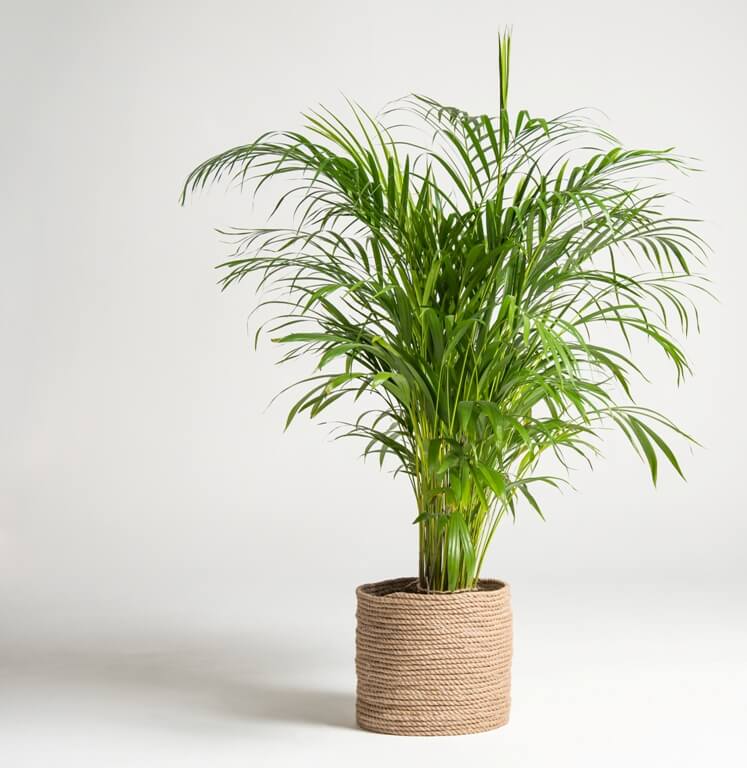Cat palm tree or otherwise known as the cataract palm or cascade palm is one of the several Chamedorea palms grown to use as an indoor plant that is native to Southeastern Mexico and Central America.
Scientifically named Chamaedorea cataractarum, the cat palm tree resembles the expensive Kentia palm and the inexpensive Areca palm.
With bright green, pinnate fronds that grow in a cromp-like fashion, this cat palm tree is a slow-growing, smaller plant that grows up to the height of 4-6 feet and doesn’t grow a trunk like other indoor palms.
Having this compact, bushy, and airy plant in your home indicates that you are high up on the social ladder, during victorian times.
Caring guide of Cat palm tree
Growth and size
Like other palms, the cat palm is also a slow grower that doesn’t grow very high. On average, it grows up to the height of 3 feet when planted indoors and 6 feet when plant outdoor.
Light
The Cat palm tree can’t grow well in direct sun. the leaves of the tree can burn by the scorching heat of the sun. instead, the plant requires bright indirect light and requires more bright light than other indoor plants. so it can grow well near a window or in a sunroom.
Although It thrives well in partial shade, it can tolerate direct sunlight if watered regularly. However, it looks slightly tattered
The cat palm tree is neither tolerant to dry soil, nor the soggy soil it requires the soil to be moist. So water the plant to make the soil moist. Click To TweetWater
Contrary to the common perception, the cat palm tree is not a desert lant like other palm trees. It requires some moisture and regular watering.
The cat palm tree is neither tolerant to dry soil, nor the soggy soil it requires the soil to be moist. So water the plant to make the soil moist. Besides never let the plant sit in the water, otherwise, it can become the victim of root rot.
Also, stay careful before using the water and ensure its content as too much saltwater and water with high chemical content can burn the leaf tips. So water the plant regularly with distilled water.

Soil
The cat palm tree grows well in the organic-rich, sightly acidic, well-draining potting soil with a high drainage system. It doesn’t like to grow in heavy soils like clay. So you can add peat moss to keep the soil light.
If you are planting the tree in a pot, then use a pot with a drainage hole at the bottom which ensures the proper draining.
The soil mixture for the growth of the plant need not be fancy. You can use the African violet mixture that provides a good combination of Airness and drainage to retain water. If you are making the mixture yourself, make a combination of potting soil, perlite, peat moss, and some bark chips if possible.
Temperature
Cat palm tee do well indoors as their ideal temperature is the same as that of humans. This plant requires 80 degrees Fahrenheit during the day and 45 degrees Fahrenheit at the night to grow. This plant is hardy to USDA zone 11 to 12.
Although the plants like heat, exposing them to too much heat can leads to leaf damage. So you should always avoid placing the plant near a heat vent or draft.
Just like that, don’t expose the plant to draft and so much cold as they are intolerant to too much cold for an extended period of time.
Humidity
The most important thing that the plant requires to grow is humidity. That’s why it doesn’t do well indoors. However, being exposed to too much dry air can damage the leaves of the plant.
The ideal humidity that the plant required is 55 percent. If the growing area of the cat palm plant has lower humidity than this, you can use a humidifier or a wet gravel tray to increase the humidity. You can also mist the plant with the help of a spray bottle.
Fertilizer
During the active growing season, the cat palm tree requires to feed with a balanced liquid fertilizer monthly during the season of spring and summer.
Granular slow-release fertilizer is a great option for this plant to feed with. It contains a certain amount of micronutrients that keep the plant lush and green.
During fertilization, always stay careful and not overfertilize the plant as it can damage the growth.
keep the plant clean
Fronds of the cat palm tree are generally dust-catchers. So the plant requires regular cleaning. To make them clean, wipe the plant with a damp cloth or clean the foliage of the plant with a warm shower.

Pruning cat palm leaves
Excess fertilizer, overwatering, and scratching by the sun can turn the leaves of a palm tree brown. Removing these leaves can enhance the look of the plant, and keep the foliage green and shiny.
Use sharp pruning shears To cut the fronds of the cat palm at its base, use a sharp pruning shear. Trim the leaves of the plant to get rid of dead foliage or to remove new growth near the plant’s base. During the pruning process of the palms fronds, make sure that you don’t damage other stems on the plant.
pruning is rarely required by the plant to encourage more growth, as these plants have a natural bushy growth.
Repotting of the palm tree is required every 3 years. Click To TweetRepotting of the tree
The plant doesn’t require regular repotting to thrive, as it is a slow grower. Repotting of the palm tree is required every 3 years. To limit the plant size, you can crowd the roots of the plant by using a pot slightly larger than the previous pot while repotting.
Never pot the palm so deeply. Always keep it into the same depth like the previous one otherwise the stems can rot. Don’t try to spread out the roots, instead keep the root intact as much as possible since they are quite brittle.
Repotting of the cat palm tree can be effectively done by the following procedure
- Remove the cat palm plant from its existing pot gently.
- Untangle the roots if required and trim the dead, brown, or mushy roots as needed.
- Fill a new, larger pot with appropriate potting soil for the cat palm plant and put the palm plant so that the plant grows at the same height as before.
- Water regularly and put the repotted cat palm in a bright place.

Cat palm tree propagation
If you are growing the cat palm tree from seeds, it can take a long time to sprout or germinate. Being a slow-growing plant, the seedlings can also take a few years to grow and develop into a salable plant.
Although the roots of the plant can be found to be bunched together, dividing them can be a little riskier as the roots are brittle and they are more likely to cause the death of the plant.
The propagation of the cat palm tree can be done by the following procedure
- Remove the cat palm from the pot and find out the sucker with more roots.
- Cut the offset from the main plant using a sharp knife.
- Fill the new pot with the required cat palm soil for growth and put the new palm plant in the pot.
- In order to increase humidity, cover the propagated cat palm with a plastic bag.
- Put the plant in a bright sunny place, but out of direct sunlight.
- Water the plant regularly when it dries out.
- Remove the plastic cover after some days and care for the cat palm tree as usual.
- Common pests and diseases
- The cat palm tree is generally not susceptible to pests, but sometimes it can be affected by spider mites. Check the plant regularly to avoid the plant getting attacked by spider mites. Raising the humidity of that area can help to prevent them to spread.
Dry soil, lack of humidity, use of salty water and tap water containing a greater amount of fluorides, and excessive fertilization can certain symptoms of damage like the browning of leaf tips.
Conclusion
Reading the article this far might provide you with all the information, growing, and caring guidance of a cat palm plant.
The cat palm tree is very much to take care of and requires low maintenance. This beautiful and attractive plant is non-poisonous and safe for kids and pets. Besides that, it cleans the air from harmful pollutants which adds another advantage to bringing it home.
So planting a cat palm plant indoors or in a garden will be worth it.






